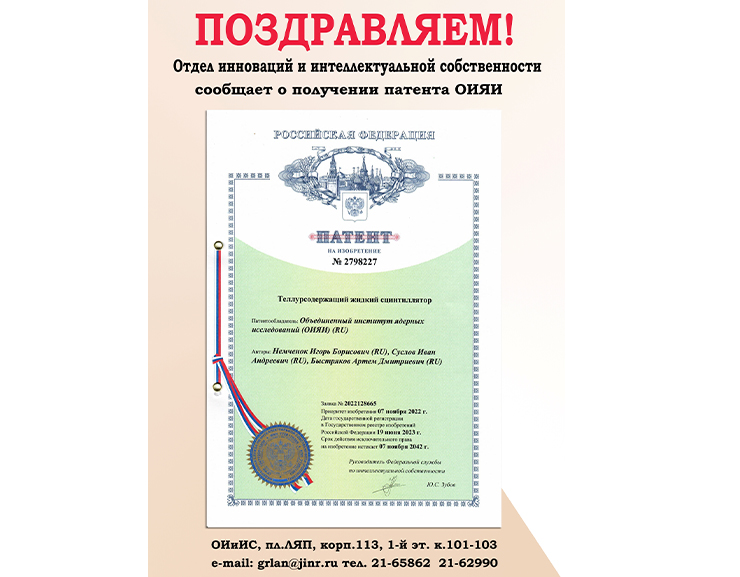Liquid scintillator to search for neutrinoless double beta decay developed at JINR
News, 15 August 2023
A group of JINR scientists has developed and patented a tellurium-loaded liquid scintillator (TeLS) with improved characteristics compared to its analogues developed before. A special tellurium-containing additive does not significantly decrease light yield and allows specialists to use the development for large-scale experiments on the search for neutrinoless double beta decay, as authors explain.
Double neutrinoless beta decay is a very rare type of nuclear decay. It was predicted by theoretical physicists several decades ago, but nobody has been registered it yet. The discovery of neutrinoless double beta decay may shed light on the absolute masses of neutrinos and their hierarchy. The registration of this process will be direct confirmation of new physics beyond the Standard Model of Elementary Particles.
Specialists are currently conducting several experiments on the search for neutrinoless double beta decay. The LEGEND Experiment is one of them, in which employees from the Joint Institute participate. At the same time, researchers are improving methods and materials for its registration, including scintillators, which are materials that emit light upon absorbing ionizing radiation.
Liquid scintillators are in high demand for the registration of neutrinos characterised by extremely weak interaction with matter. Scientists can directionally modify their composition, thereby increasing the effectiveness of registration of these particles. At the same time, detectors themselves can have almost any volume and shape.
On 19 June 2023, JINR scientists received a patent for a liquid scintillator based on linear alkylbenzene (LAB) loaded with tellurium. As scientists highlighted, 130Te used in the development is the most promising type of tellurium and any other elements for experiments on the search for neutrinoless double beta decay.
“We have developed material mixed with a 2,5-diphenyloxazole scintillation additive and a 1,4-bis(5-phenyloxazol-2-yl)benzene secondary scintillation additive. For the first time, we used a complex compound of diphenyltellurium oxide with di-(2-ethylhexyl)phosphoric acid as a tellurium-containing additive. Thus, we have managed to significantly improve qualitative characteristics of the scintillator,” one of the researchers, Head of the Group No. 1 of Organic Scintillation Detectors of the Scientific and Experimental Department of Nuclear Spectroscopy and Radiochemistry of the Dzhelepov Laboratory of Nuclear Problems at JINR, Doctor of Technical Sciences Igor Nemchenok said.
Scientists were studying optical properties of scintillators, such as transparency and light yield, depending on the concentration of tellurium. They were also conducting comprehensive research on the composition optimisation of the scintillator and studying the effect of secondary scintillation solvent on light yield.
“Light yield is the most important characteristic of scintillators. They generate light when a particle or radiation passes through them. The more light they emit, the better they are as scintillators. To create our scintillator, it was necessary to load tellurium into organic liquid. We have managed to find a tellurium compound that dissolves well in the main substance of the scintillator and at the same time does not significantly worsen its properties, in particular light yield,” the scientist explained.
One of the possible place where the new scintillator could be used is the Jiangmen Underground Neutrino Observatory 150 km west of Hong Kong in China (the JUNO Project, in which JINR has been already involved for several years). A 20-thousand-ton liquid scintillator detector will be used to solve a number of the most interesting problems of neutrino physics. The main scientific goal of the experiment is to study neutrino oscillations.
“When the experiment is launched and completes its programme, researchers will want to continue using such a huge detector. That is why fellow physicists are currently thinking about what can give it a second life. An experiment on the search for double neutrinoless beta decay could be an option here, so we will be able to offer our tellurium-loaded liquid scintillator to be used for such an experiment,” – Igor Nemchenok highlighted.
